How to Pre-Sell a Course: 8 Steps to Secure Sales Before You Launch
0 comments
0 comments
Tell me if this sounds familiar…
You’ve spent hours (and lots of money) creating your course and perfecting your launch, and you’re hoping for a big splash to make it all worth it, right?
What if I told you that your next online course could make 5 figures before you press “Launch”? Or what if there were a way to find out if your next course topic won’t be the smash hit you were expecting it to be?
It's a not-so-well-kept secret on the internet: preselling.
By selling spots in your course before you launch, you can ensure you provide exactly what your students want and drum up some sales before your big marketing push.
In this article, I’ll walk you through the essential steps for how to presell a course so you can be confident that it will be an unrivaled success. So grab a cup of coffee and your notebook, and let’s get started!
Preselling an online course means launching your course to a small, private audience to secure upfront sales and gather feedback before the big launch.
This isn’t just a tactic for course creators. Many businesses presell to generate excitement and revenue before doing a more extensive public release of their products or services. From software and gadgets to books, you are in good company by preselling your next online course! Preselling your next course will give you:
No matter what you’re preselling, there’s one universal guideline you need to follow:
Be transparent! Be clear with your audience that your course is not fully created yet. You can position this as a perk for your students by offering a discount and providing them with exclusive early access to your course.
So instead of throwing darts in the dark, follow the steps in this article, and you’ll be a preselling pro in no time!
Is preselling really worth the extra effort?
If you aren’t sold yet, here are six key benefits of preselling your online course:
Let’s walk through each of these in depth.
Preselling can help create a buzz about your course by generating excitement and anticipation among potential customers.
Ever heard of Amy Porterfield? She often presells her courses to her followers through social media, her website, affiliate partners, and webinars. For example, she had a pop-up on her site when she was about to release her newest list-building course. Anyone visiting her site was then enticed to learn more:
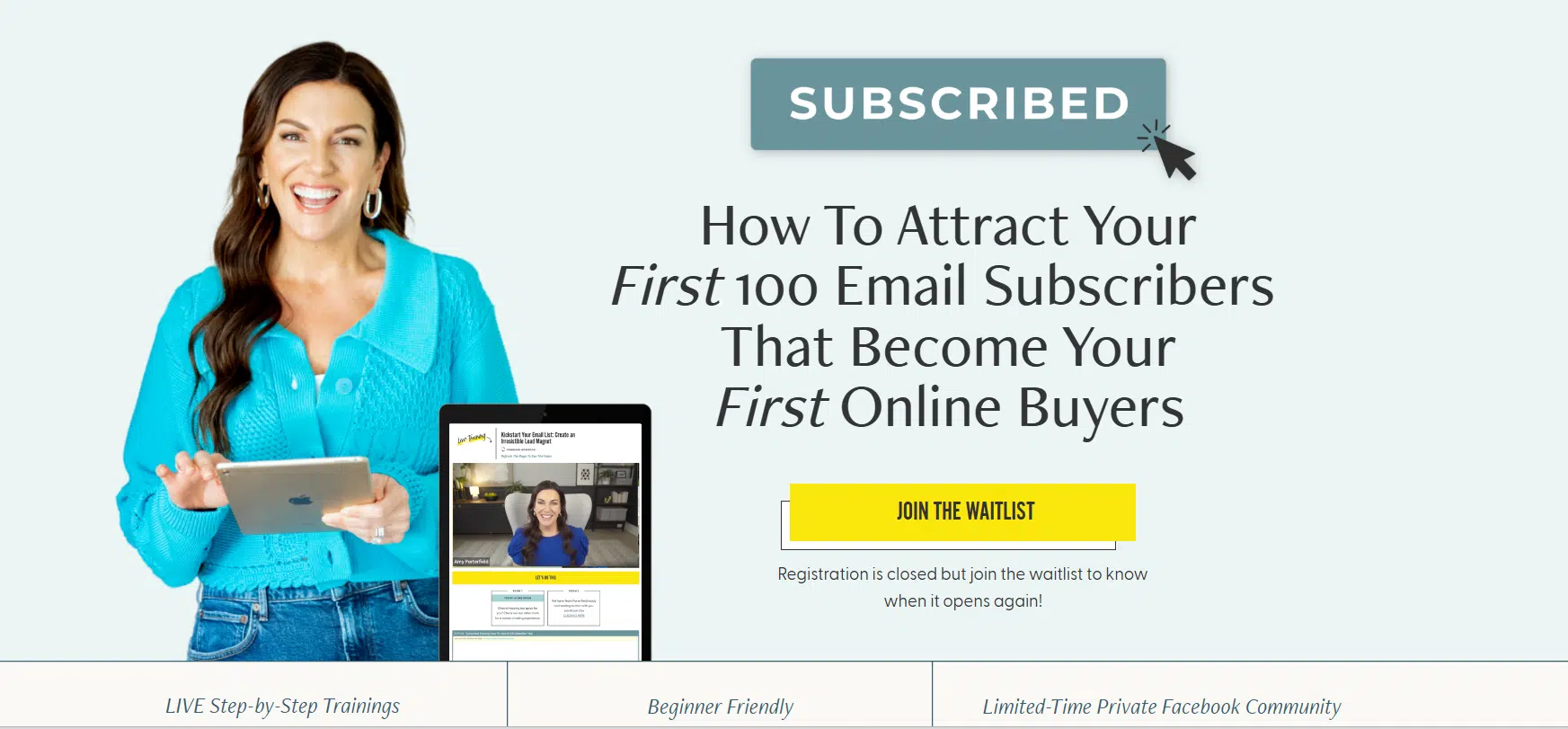
The word-of-mouth marketing she gets from preselling her course increases her fans’ excitement and interest, accelerating enrollments before the course goes live.
Another advantage of preselling is that it brings in cash you can use to create your full-length course.
As a course creator, you may need to invest in things like video equipment, software, a good microphone, hosting, or outside help. These expenses add up quickly and can stop you from creating your course if you’re on a tight budget.
By preselling your course, you can manage your cash flow and only spend on the items you need once you have the funds.
Building a comprehensive course is a big commitment that comes with a lot of risk if you haven’t fully tested the concept and curriculum.
You could end up spending weeks and months creating your course without any guarantee that it will sell.
Preselling helps you validate your course idea before you put in all that hard work. When you know people will pay for the course, you can sleep at night knowing your time will be well spent.
Pre-sales are a future forecast of the degree of success of your course. The more enrollments you get now, the more confident you can be about your course’s profitability in the future.
Since you’ll be delivering your course before it’s entirely created, preselling allows you to tailor the content as you go. If you build interaction into all the elements of your course, you can get feedback about what’s working and what isn’t. Then, you can tweak any aspects for the larger launch.
The information you learn about your customers’ challenges will also help you with your marketing material. You’ll be able to use the same language and examples you now know will resonate with your target audience.
There is nothing (and I mean absolutely nothing) that sells a course better than testimonials from happy customers.
Assuming your preselling strategy worked, your course sales page will be chock-full of praise from your early-access students to warm up prospective students to buy. You can’t get these testimonials without offering that early access, though, and that’s where preselling becomes mission-critical.
Gather up these testimonials and pepper your sales page with them. Make sure to display them on your sales page and give your visitors a better picture of what your product or service can do for them. When your prospects see that you provide proven results, they feel more confident about clicking that ‘buy’ button.
Consider using tools like Thrive Ovation (from Thrive Suite) in WordPress to show a variety of testimonials dynamically. In the following example, I have my plugin set to rotate through 4 different ones.
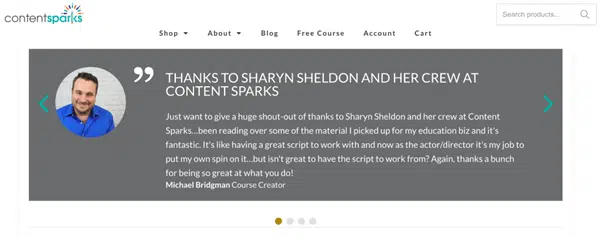
Not only will these testimonials add a splash of authenticity to your sales page, but they’ll also give you critical insights into what your customers find the most valuable about your course.
Making sales gets all the glitz and glamor, but it’s not the only benefit of preselling. If there’s one thing I’ve learned from creating and launching hundreds of courses, it’s that when you get into the thick of it, you’ll be tempted to take a break - or maybe put your course on the shelf and finish it at a future date.
Preselling a course means no excuses to procrastinate. You sold spots and must create that course for your eager audience! For course creators who are perfectionists, preselling also forces you to decide what is 'good enough' for the first delivery of your course.
Now that you know why to presell your course, let’s discuss the steps for doing it successfully.
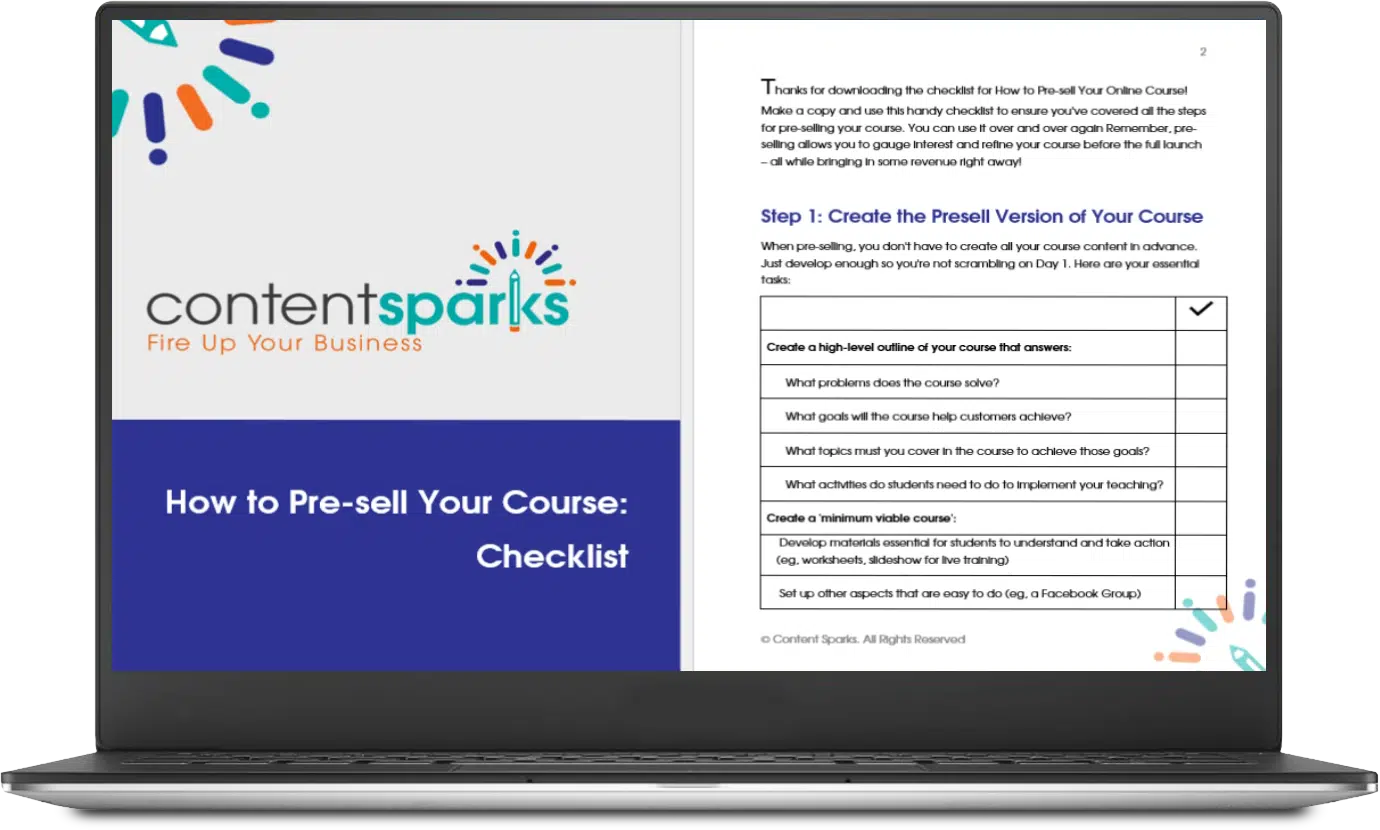
How to Pre-sell Your Course: Checklist
Request your free copy of the How to Pre-sell Your Course Checklist to guide you step-by-step.
It’s time to roll up your sleeves because I’m going to lay out a blueprint for you to follow to presell your next online course.
I like to break preselling into the following steps:
![Blog Post - How to Pre-Sell Your Course How to Presell Your Course [8 steps]](https://contentsparks.com/wp-content/uploads/2025/06/Blog-Post-How-to-Pre-Sell-Your-Course.png.webp)
You’re going to need a course (obviously), but here’s a little secret to preselling strategically.
Preselling is about more than making some discounted sales before your official launch. By preselling your course, you will gather valuable insights and feedback to inform your course launch when you’re ready to shout it out from the rooftops.
Because of this, it’s okay to create a slimmed-down version of your course – an MVP (minimum viable product), if you will. Just because this course isn’t ready to go live to the masses doesn’t mean you should breeze through all the steps to create a successful course. You still need to…
Start by creating a high-level outline for your course that answers questions like:
Once you know what you’ll cover in the course, decide on the amount of content you need to create for the presell version of the course.
Ask yourself the following:
This outline and list of contents will help you create a presell sales page for your course. If people have enough information about the course and book spots during presell, it means there’s good potential for success when you do a bigger launch down the road.
Here’s an example of what your presell course outline might look like:
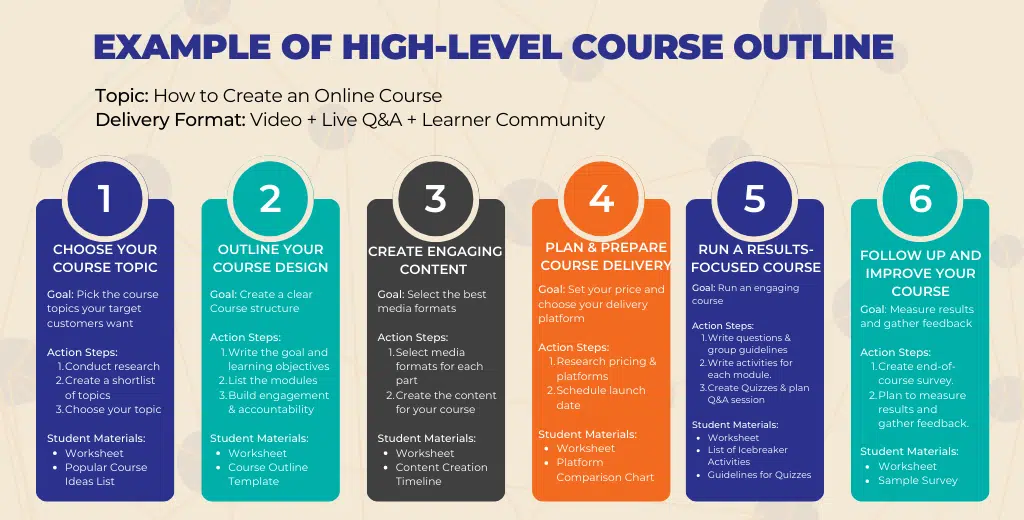
Once the course is ready, it’s time to lay the foundation for your launch by setting the price.
This isn’t the final price for the course that you’ll use for its official launch. Instead, it’s common to offer a discount (sometimes a steep one) to those who pay upfront to access the course before anyone else.
While this will be a discounted price, it should be high enough that the effort you put in is worth your while. It’s also important to charge people something to give you a sense of how enticing the offer is and whether you can justify a higher price for the course later on.
Check out my complete guide to pricing an online course for a full walkthrough of this, and come back here when you determine your price.
You have the course and a presell price, so let’s get to work!
Once the key pieces of your offer are in place, it’s time to develop a high-level strategy for your presell launch. I like to break that down into the following steps:
I’ll walk you through each of these steps next.
You’re selling the course to make more money, but that’s a pretty loose goal – especially when working around the tight timelines of preselling.
I’m a big fan of the SMART goal framework; these are goals that are:
Before you write a sales page and throw caution to the wind, sit down and ask yourself what success looks like. If you’re trying to drum up sales, how much revenue makes this a success? If you want feedback, what is the nature of the input you need, or how many responses do you need? Doing this bit of prework will guide the rest of your strategy and help ensure your launch really is the success you hope for!
Now that you have a goal, let’s narrow your focus to a target market to focus your presell activities around.
Whether you call them “buyer personas” or “ideal customer profiles,” you will need a sense of who you will presell to. Ideally, you defined your target market when outlining the course. Either way, it helps to take a moment after you set your goals to jot your notes down again. If you’re stumped, start by answering these questions:
For example, if you’re creating a course named Small Business Finances, you know small business owners (CFOs in some cases) would be the best people to advertise your course to.
Finally, you should gather up the collateral you will need to presell your course.
At a minimum, you should have:
I’ll go into specifics on these later. I find it’s helpful to start with a sense of what content you wish to create to sell to your defined audience to reach your goals, rather than scrambling and finding out you’re missing something later.
If you have a very small audience of your own, you could open it up to followers of people in your network, allowing them to earn commissions on both presells and later sales during the bigger launch.

How to Pre-sell Your Course: Checklist
Request your free copy of the How to Pre-sell Your Course Checklist to guide you step-by-step.
Now that you have your general marketing strategy, it’s time to get down to the nitty-gritty of exactly how you’ll meet your preselling goal.
I’ve included a few ideas below to get you started, but check out my list of course promotion tactics that you can try. These will be especially handy for your big launch! The top channels I’d start with are:
I’ll walk you through each one next.
Free resources, AKA lead magnets, are the best way to attract customers during preselling, and you’ll have that list for when you do a larger launch, too. Providing value to your prospects for free will help you ramp up presell course enrollments.
My top recommendations for simple lead magnets that will entice people to sign up for your email list. Just make sure that the one you choose is directly related to your course and leaves people with a quick win, but also wanting to learn more:
The idea here is to offer a discounted price or extra content during your preselling period to encourage customers to commit early. Make it clear this early bird special is available for a short period, so they book a seat in your preselling session.
I use the same concept when doing an ‘early bird launch’ of some of our courses:
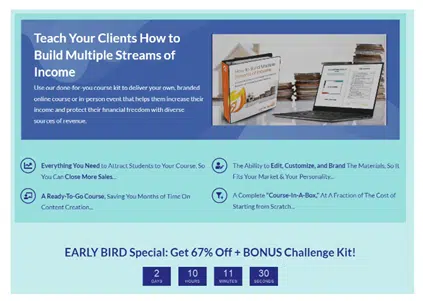
Showing people the number of spots left when preselling a course moves it to the top of their priority list. It gives them the urgency to stop procrastinating and act quickly to secure their place in the course before it fills up.
Plus, seeing that others have already enrolled creates a sense of FOMO (fear of missing out) and confidence that they’ll be part of a group experience.
Host webinars and live streams to give your prospective students a taste of what your course offers. This gives them a chance to get to know you and the expertise they’ll benefit from if they enroll in your course. Use these events to showcase your knowledge, answer questions, and provide such incredible value that your audience says, “Wow! If this is what she’s giving now, I can’t wait to see what’s in her course.”
Get more visibility for your course by posting regularly on social media. But make sure to choose the right platform for your audience. For example, if you're targeting business professionals, LinkedIn may be more effective than Instagram.
Once you’ve decided where your target audience is on social media, consistently share valuable content and engage with your followers to build momentum. If you don’t already have an audience on social media, start building one immediately by participating in relevant groups and answering questions BEFORE you share anything about your course.
Show your audience that you're an expert in your field by creating high-quality blog posts related to your course topic.
Your blog posts can cover a variety of topics related to your course, such as:
Pro tip: Remember to include a CTA in your blog post, such as a link to your presell landing page or a signup form to join the waiting list.
Got your channels? Let’s move on to gather the sales and marketing collateral you will need for the launch.
Once you have the strategy and promotion channels set, gathering your collateral for the launch can be pretty simple (especially if you get a boost from white label PLR content you can use out of the box).
Depending on which tactics you choose from the previous section, this collateral may change, but at a minimum, you will need:
You can easily set up a waiting list through your email marketing platform with a simple landing page and opt-in form that offers first access to your course. By setting up a waiting list for your course, you can:
Here’s an example of a simple landing page and opt-in form for a waiting list for a course from Learn Digital:
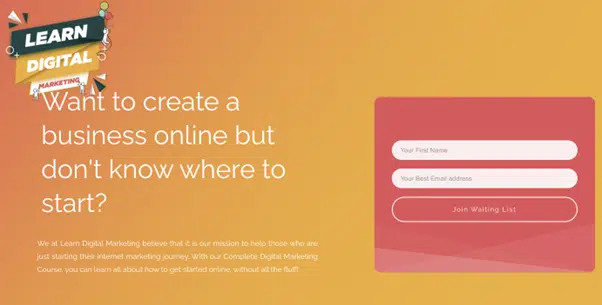
A landing page is an easy way to lay out all the benefits, features, and other essential information about your course. You already have the information you need for the page from the steps where you outlined your course and decided on your preselling strategy. So now it’s just a matter of picking a suitable template from a landing page builder, adding the details, and linking your buy button to whatever checkout or payment system you’re using (such as Thrive Cart).
The key elements to include in your presell landing page are:
Check out my complete guide to creating a course sales page for more information!
If you already have customers, emailing them is one of the easiest and most cost-effective ways to presell your course. They’ve already bought from you once, so they will most likely be interested in buying again.
Consider also giving your customers VIP first access or an ‘insider’ price for your new course to make them feel even more special.
Here’s a simple template you can use to email your existing customers about the course you’re preselling:
Subject: Get first access to my new course!
Hey [Customer Name],
I'm thrilled to let you know about my upcoming course, available for presell now! I’ve designed the course to help you [briefly describe the benefits of the course].
But here's the catch: I’m offering a limited number of seats at a special customers-only pre-sale price. Once they're gone, the price will go up.
That's why I wanted to give you the first opportunity to book your spot and take advantage of this insider’s offer. Simply click the link below and follow the instructions to complete your enrollment.
[Insert Link]
Thanks for being a loyal customer. I hope to see you in the course!
All my best,
[Your Name]

How to Pre-sell Your Course: Checklist
Request your free copy of the How to Pre-sell Your Course Checklist to guide you step-by-step.
Don’t leave your newly enrolled students twiddling their thumbs, wondering what happened to you. Use these tactics to keep them excited about your upcoming course and in a mindset that will have them ready to take action from day 1.
Nothing creates urgency for buying like a countdown timer. Use that same concept to let your enrolled students know exactly when the course will be available, and they'll be motivated and eager to jump into action on Day 1.
Here’s an example of a countdown time on Dribble
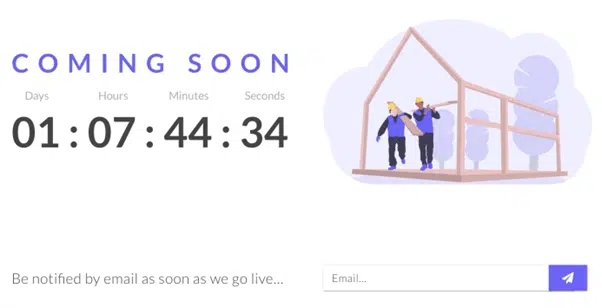
Creating an email series to keep your students updated on your course's ETA can be a great way to keep them engaged.
Here are some tips to make the most of your email series:
If you want to avoid doing an email series, leverage your social media community to talk about the course and keep students updated on its progress.
Once you've finished preselling your course and enrollment is closed, it's time to start teaching your presell version and creating the materials you decided on.
You can also ask for feedback from students in your presell group as you teach each lesson. Then tweak the content as you go, based on that feedback. That’s another benefit of having only outlined the content in advance and not creating it all at once.
If you created a community for your new students, you can ask for feedback there and have a discussion about what they’d like added or changed.
Once you’ve finished delivering your presell version of your course, be sure to collect testimonials that you can use for social proof for your next sales page and launch. Gather both written and video testimonials for greater credibility and impact if you can.
Lastly, ask people who were interested in the course but didn't buy in the presell about why they didn't enroll. This gives you more info about how you might adjust your messaging or the course itself when you do a full launch.
You’ve pre-sold your course to at least a small group, delivered it to them, and gathered their feedback and testimonials. Now it’s time to plan your full course launch. But before you start your launch to-do list, complete the following:
Ready to take the next step and do a full launch? Be sure to follow our Complete Online Course Launch Checklist: Your Blueprint for Success.
Whew, that was a lot of ground we just covered!
If you couldn’t (or just didn’t want to) read this in one sitting, I’ve got you covered. Click the button below to download a free checklist for how to presell your next online course. It’ll walk you through the material we just covered to guide you through a successful launch.
Even if you’re just creating a minimum viable course for preselling, developing a course from scratch can be overwhelming, time-consuming, and expensive!
Rather than spend your energy and time creating a course, focus more on selling by purchasing a brandable, white-label course. Browse hundreds of ready-to-sell courses in our shop here:
Check Out Our Full Range of Courses in the Shop
Teach Yourself. Then teach your audience.

You can use our done-for-you courses however you want. You can sell them as-is after personalizing the content with your name and branding. Or, use parts to create a minimum viable course for preselling.
Just follow the steps for preselling in this article, using your new white-label course to create a minimum viable course version to sell!

Tags